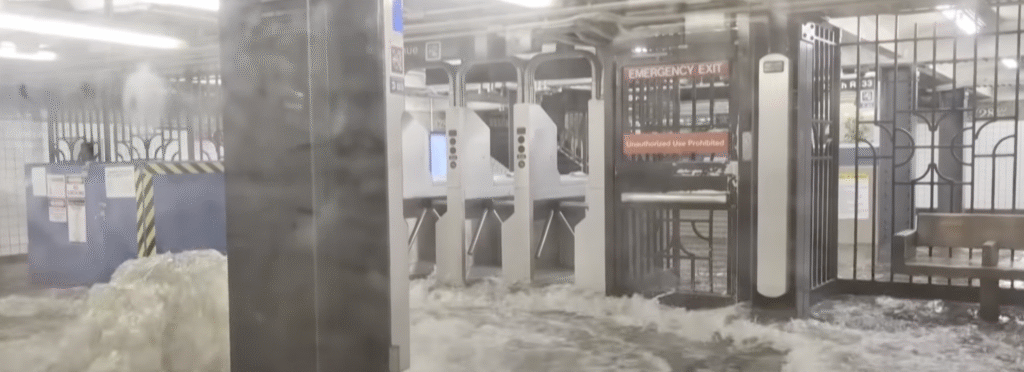News
Flash Floods Paralyze New York City
Heavy rains and flash flooding struck New York and neighboring regions on Monday, July 14, 2025, causing widespread disruption to transit, infrastructure, and daily life. The severe weather prompted flash flood warnings across all five boroughs of New York City and parts of the wider metropolitan area, with New Jersey Governor Phil Murphy declaring a state of emergency and urging residents to stay indoors.

Impact Across the Region
- Public Transit & Roads:
- Subways in New York City experienced significant flooding and delays, with several lines temporarily suspended.
- Footage captured water erupting through subway station turnstiles and inundating train cars, notably at Manhattan’s 28th Street station.
- Above ground, highways and main thoroughfares like the Saw Mill River Parkway, Cross Bronx Expressway, FDR Drive, and Harlem River Drive were submerged, leaving vehicles stalled and traffic at a standstill.
- Regional airports, including JFK, LaGuardia, and Newark, saw flight cancellations due to runway flooding and hazardous travel conditions.
- Residential and Community Risks:
- Residents of basement apartments – including significant low-income and immigrant populations – were put on high alert due to sudden flood risks, with emergency officials advising they be ready to evacuate at a moment’s notice.
- In neighborhoods such as south and east Brooklyn, south Queens, the east coast of Staten Island, and the East Bronx, housing is particularly vulnerable to flooding, compounding risks for the city’s most underserved residents.
- Emergency Response:
- Rescue workers acted swiftly to assist motorists trapped in rising waters, with some locations requiring wading through neck-high floods to reach those stranded.
- The National Weather Service warned drivers of the dangers of attempting to cross flooded roads, reiterating “Turn Around, Don’t Drown,” since nearly half of all flash flood fatalities occur in vehicles.
Causes and Contributing Factors
Meteorological experts note that climate change is intensifying rain events in the region. Warmer air retains more moisture, leading to rainfall that is both heavier and falls in shorter, more intense bursts. Events like the July 2025 flash floods are becoming more frequent, mirroring earlier disasters such as the devastation from Hurricane Ida in 2021 and the record September 2023 floods.
The city’s aging combined sewer infrastructure—where stormwater and sewage travel through the same pipes—exacerbates the risks. Overflow during storms can send untreated waste into homes and adjacent waterways, leading to not only property damage but significant impacts on marine ecosystems and public health.
Vulnerable Groups and Long-Term Risks
- Low-income and immigrant populations are disproportionately affected, as they often inhabit high-risk areas and basement apartments.
- Urban development, insufficient green infrastructure, and outdated drainage systems make the region especially susceptible to flooding, a threat compounded by rising sea levels and more unpredictable storm patterns.
- Pollution from floodwaters, which can carry debris, chemicals, and sewage, poses lingering dangers to both communities and natural habitats.
Looking Forward: Adaptation and Preparation
City and state authorities have emphasized the need for improved infrastructure and better emergency preparedness. Experts recommend the city:
- Expand green infrastructure (such as permeable pavements and rain gardens) to better absorb stormwater.
- Retrofit or upgrade aging sewer systems.
- Continue public education on flood risks, especially for high-risk residents in basement apartments.
- Maintain and enforce evacuation protocols during flash flood emergencies.
Further, individuals are urged to heed official flood warnings, avoid driving through floodwaters, and have an emergency plan ready, particularly those living in vulnerable housing or coastal areas.
New York’s flooding challenges are ongoing and multifaceted, demanding coordinated action to address both immediate dangers and the long-term risks posed by a warming climate.